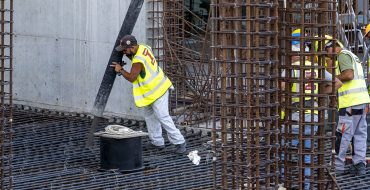
Researchers harness algae to ‘grow’ construction cement
By BRUCE FINLEY
Read the original article here.
DENVER (AP) — The massive worldwide pouring of concrete as developers densify cities could be transformed, eliminating heat-trapping pollution into the atmosphere, by switching to a new kind of cement created in Colorado — cement that is “grown” by harnessing tiny sea organisms.
Urban concrete jungles also would look less gray because the new cement is lighter in color and more reflective.
The U.S. Department of Energy this month embraced University of Colorado research that developed this cement, investing $3.2 million for scaling up cultivation of an algae species called coccolithophores. CU’s innovation appealed to the DOE’s Advanced Research Projects Agency because cement production causes 7% of the global heat-trapping pollution that accelerates climate warming. That’s a significant share, exceeding emissions from airplane travel.
“This is a carbon dioxide removal project,” said CU Boulder materials scientist Wil Srubar, leader of the work and director of CU’s Living Materials Laboratory, who got got the idea while snorkeling in Thailand on his honeymoon in 2017. He saw “magnificent” natural limestone structures in coral reefs and wondered whether humans could replicate natural processes to make enough limestone for cement — instead of excavating limestone from quarries.
The CU researchers essentially are industrializing the way coral reefs and plankton create limestone. The microalgae coccolithophores blooming in oceans use sunlight, seawater and dissolved carbon dioxide to produce calcium carbonate (limestone), which is contained in their bodies and shells — and they make limestone much faster than expanding coral reefs.
“All we’re doing is switching the source of limestone from scooping it out of the ground to growing it using algae,” Srubar said. “If we can make the total switch – switching from quarries to the grown limestone using microalgae coccolithophores – we will circumvent 2 gigatons per year of carbon dioxide emissions.”
That calculation assumes urban construction growth at current rates around the planet — a booming pace that construction industry groups estimate has tripled over the past four decades, adding the equivalent of a New York City every month.
Shifting to carbon dioxide-neutral production of cement would help contain the climate warming that has led to worse droughts and wildfires. And the construction industry has shown interest in tackling this problem, Srubar said. A shift to cleanly-produced cement also would improve, slightly, the urban heat island effect that amplifies warming because whiter cement would not absorb as much heat as the gray.
Urban developers rely on cement made using limestone from quarries — often controversial due to truck traffic and degradation of landscapes — and burning it in kilns at temperatures topping 2,500 degrees. The burning releases carbon dioxide from limestone rock into the atmosphere.
Concrete now ranks as one of the most prevalent materials on the planet, made from mixing water and portland cement into a paste and whisking in sand, gravel and crushed stone before hardening. In contrast, algae naturally create calcium through photosynthesis that captures carbon dioxide.
Federal funding awarded this month is meant to launch CU Boulder engineers working with colleagues who collect and grow algae at the University of North Carolina in Wilmington and with energy scientists at the DOE’s National Renewable Energy Lab in Golden who envision “biogenic limestone-based cement” as crucial for meeting the nation’s goal of reducing carbon dioxide in the atmosphere.
The algae would have to be grown in ponds, and these would cover roughly 2 million acres overall to meet U.S. construction industry needs, Srubar said. That’s about .5% of the nation’s land. The researchers envision dispersed ponds for economic efficiency in delivery of cement. Starting within two years, researchers will embark on largescale cultivation of the organisms at facilities in Arizona, he said.
“It is all about growing the cities of the future.”